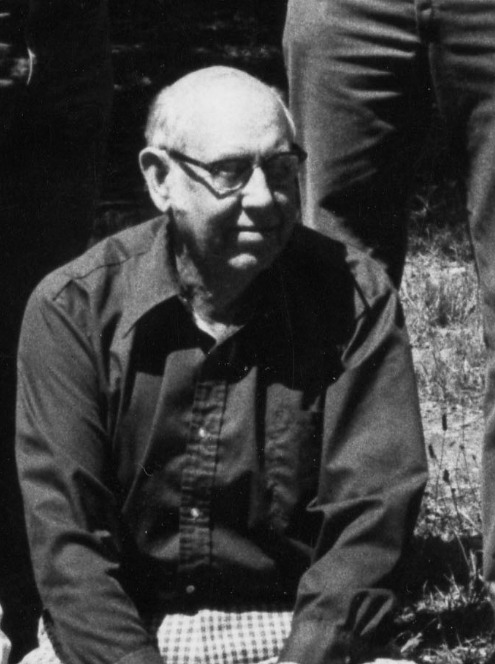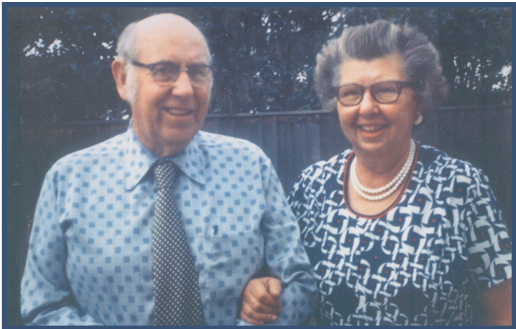Aaron and Elizabeth Waters Student Research Fund

Purpose: The Aaron and Elizabeth Waters Student Research Fund is named in honor of the founding Chair of Earth Sciences at UCSC and his wife. This fund supports graduate students in the Earth and Planetary Sciences (EPS) Department at UCSC as they conduct thesis-related research. The department makes annual awards from the Waters Fund to the most meritorious research proposals submitted each year as part of PhD students qualifying for candidacy. The Waters Fund endowment can now provide graduate fellowship support as well.
History: Aaron Waters had a distinguished career in Earth Sciences spanning >60 years, publishing his first paper in 1927, and founding the Earth Sciences program at UCSC in 1967. He was elected to the National Academy of Sciences in 1964, and received the Penrose Medal from the Geological Society of America in 1982. Dr. Waters worked on a wide variety of problems in the fields of volcanology, igneous petrology, mineral resources, lunar geology, and the regional geology of the Pacific Northwest. Dr. Waters retired from UCSC in 1972, and donations from his former students, colleagues, and friends led to the establishment of this fund. The Aaron and Elizabeth Waters Student Research Fund recognizes the important roles that Elizabeth played in educating generations of students. 
Status: The Waters Fund is currently endowed with ~$350k. Income from the fund supports graduate fellowships and annual awards for outstanding PhD thesis proposals. Awards are made on a competitive basis each year.
Long-term Goal: Our long-term goal is to grow the endowment to $1M, to generate the equivalent a full academic year of graduate student support.
Our Request: Please contribute to the Waters Fund and help to support EPS undergraduate and graduate student researchers. You could make a one-time donation or pledge to give annually.
Donations in honor of Aaron and Elizabeth Waters have made this award possible. Below are previous awardees.
- 2023 Kristin Dickerson Measuring and modeling marine geothermics and hydrothermal circulation on Earth and other ocean worlds
- 2022 Keenan Hassell The response of coralline algae to climate change throughout the Cenozoic
- 2022 Maddie Wood Applications of stable strontium isotopes to quantify carbonate deposition and dissolution in the past ocean
- 2021 Will Chapman River networks as records of land use history and climate change
- 2021 Garrett Zeff High Pressure Melting in Planetary Bodies: The Role of H2O and CO2
- 2020 Coby Abrahams Iron Magmas, Magma Oceans, and Ocean Worlds
- 2020 Huazhi Ge 3-D Atmospheric Dynamics and Planetary Formations of Jupiter: Numerical Modeling on Atmospheric Dynamics in Hydrogen Atmospheres and Planetary Formation in Protoplanetary Disk
- 2020 Colleen Murphy Feedbacks between groundwater flow and landslide failure
- 2019 Graham Edwards Application of the uranium decay chain to diverse problems in deep time and Quaternary studies: Chronologic insights into processes of planetary interiors and the bases of glaciers
- 2019 Heather Shaddox From the Lithosphere to the Hydrosphere Seismology: A Tool for Understanding Ubiquitous yet Egnimatic Processes
- 2018 Galen Gorski Linkages at the interface of the nitrogen and hydrologic cycles: Effects of climate change and implications for water resources
- 2017 Cara Vennari Nitrogen and Carbon in the Deep Earth: A Mineral Physics Perspective on the Stability of Volatiles
- 2016 Carolyn Branecky High special variability in geothermal heat flow in West Antarctica and its implications for ice sheet dynamics
- 2015 C. Grace Barcheck Characterizing basal processes of the Whillans Ice Plain using passive seismic and GPS observations
- 2015 Sarah Beganskas Exploring methods to enhance groundwater supply and quality through managed aquifer recharge
- 2015 Allison Pfeiffer Geomorphic controls on the size and spatial distribution of gravel in CA Coast Range rivers; with implications for salmonid habitat
- 2014 Delphine Defforey Phosphorus Cycling in the Deep Subseafloor Environment
- 2014 Erin K. Todd Investigation into shallow subduction zone strain release modes and seismic coupling
- 2014 Sarah White Interannual climate variability in the tropical Pacific from the Pliocene to the present: exploring drivers of ENSO
- 2013 Doug Hemingway Applications of Potential Fields: Lunar Crustal Magnetism and Titan's Ice Shell
- 2013 Alanna Lecher A Multi-Tracer Approach to Quantifying Groundwater Discharge in Multiple Environments
- 2013 Lingling Ye Earthquake Source Spectra, Faulting Interactions in Subduction Zones, and Seismic Waveform Inversion
- 2012 Karla Knudson Seasonal-To-Millennial Scale Changes In Climate And Productivity In The Bering Sea (1.2 - 0 Ma)
- 2012 Donald Penman Geochemical Proxy Insights Into The Response Of The Global Carbon Cycle And Hydrologic Cycle To Massive Carbon Injection At The Paleocene-Eocene Thermal Maximum
- 2011 Elizabeth Crook Impacts of Ocean Acidification on Coral Reefs
- 2010 Erinna Chen Dynamics of icy satellite subsurface oceans
- 2010 Jacob Walter Slip on the Edge: Large-scale, barely-observable, frictional failure of glaciers and subduction zones
- 2009 Nicholas Vanderelst Connecting near and farfield earthquake triggering to dynamic strain
- 2008 Reid Parsons Crater relaxation, viscous flow features, and gullies on Mars: Quantifying recent climate conditions based on surface features relating to water
- 2007 Kathryn Snell Hot and Cold, High and Dry? Using D47 paleothermometry and oxygen isotope analysis to untangle the climatic and tectonic histories of the Late Cretaceous, Early Eocene and Late Miocene in western North America
- 2006 Sarah Hall Forearc deformation along the Peruvian margin: Quantifying the rates of Qaternary deformation using in situ produced cosmogenic 10Be and 26Al
- 2006 Juliana Rokosky High resolution studies of lowermost mantle anisotropy: Investigating the relationship between strain transients and tremor in subduction zones
- 2006 Patrick V. Wheatley Stable isotopes as deep time proxies for understanding ancient herpetological diets and habitats
- 2005 Darren Tollstrup Evolution of Ocean Island Arcs: Sources, Processes, and Timescales
- 2005 Yingcai Zheng Upper Mantle Discontinuities and Earth's Small-Scale Heterogeneities
- 2004 Kena Fox-Dobbs The Dietary Ecology of Pleistocene and Holocene Carnivores: A Stable Isotope Approach
- 2003 Seth D. Newsome Holocene Ecological and Environmental Shifts on the Northeast Pacific Margin: Insights from the Geochemistry of Archaeofauna
- 2002 Gregory M. Stock Rates of River Incision and Landscape Evolution in the Sierra Nevada, California, from Cave Deposits
- 2002 Martha Evonuk Numerical Modeling of Convection and Magnetic Field Generation in the Interior of a Hot Jupiter
- 2001 Peter N. Adams Mechanics, Timescales and Evolution of Rocky Coastline Embayment AND Fluvial Response to Blind Thrusting: The Formation of Wind Gaps and Transverse Canyons
- 2001 Cope M. Willis Assessing Natural and Human Alterations to Coastal Sediment Supply in California and Implications for Regional Beach Sustainability
- 2000 Leslie A. Perg Cosmogenic Nuclide Constraints on Active Margin Coastline Uplift and Geomorphic Rates, Santa Cruz, CA
- 2000 Mark Clementz The Evolution of Herbivorous Marine Mammals: Ecological and Physiological Transitions During The Evolution of the Orders Sirinea and Desmostylia
- 1999 Henry Scott Hydrothermal Experiments Relevant To Icy Satellites
- 1999 Aradhna Tripati Paleotemperature Reconstructions Using Mollusk Shell Stable Isotope Profiles
- 1998 Christopher J. Pluhar Late Cenozoic Tectonic Evolution of the Eastern California Shear Zone in Southern Owens Valley, CA
- 1997 Gregory Dick Bedrock Channel Erosion: Estimates of Rates and Controls in Several Rivers
- 1997 Kristina L. Faul Paleoproductivity and Climate: Last Glacial Maximum Eastern Equatorial Pacific Upwelling, Palogene Oceanic Nutrient Budgets and Productivity
- 1996 Peter Weiler Paleomagnetic Study of an Active Arc-Continent Collision, Finisterre Arc Terrane, Papua New Guinea
- 1995 Katherine McIntyre Links Between Surface and Deep Water Chemistry in High Sedimentation Rate Sediments from the Feni Drift: Deep Water Formation and Northern Hemisphere Climate Change
- 1994 Jessica Faust The Equation of State of Majoritic-Garnet Synthesized in Natural Basalt at Mantle Conditions: Implications for Recycling of the Oceanic Crust
- 1993 Joseph Galewsky Tectonics of the Ramu-Markham-Huon Foredeep Basin and Deep Structure of the PNG Collision Zone
- 1993 Kirsten M. Menking Quantification of Weathering and Erosion in the Sierra Nevada with Oscillating Climate
- 1992 Harold J. Tobin A Proposal to Measure Velocity vs. Effective Stress in Accretionary Prism Faults: The Effect of High Fluid Pressure and Implications for Fault Hydrogeology
- 1991 Daniel L. Farber Phase Equilibria. Element Partitioning, and Diffusion at High-Pressures and Temperatures: Constraints on Production and Preservation of Chemical Heterogeneities Within the Mantle
- 1991 Gabriel M. Filippelli Variations in the Miocene Deep Sea Phosphorus Flux—Implications for the Marine Phosphorus Cycle
- 1990 Richard J. Behl The Origin of Chert in the Monterey Formation of California
- 1990 Stuart A. Gilder Relationships Between the Yangtze Craton and the South China Accretionary Fold Belt: Geometry and Evolution of a Cryptic Suture
- 1989 Eileen Hemphill-Haley Microfloral and Microfaunal Evidence for Coseismic Subsidence Related to Earthquakes Along the Cascadia Subduction Zone, Willapa Bay, Southwestern Washington
- 1988 Giovanni Guglielmo, Jr. An Examination of the Nature and Timing of Pluton Emplacement
- 1987 Daniel L. Orange Determining the Role of Fluids and Mass Transfer in Controlling the Physical, Chemical and Structural Evolution in Accretionary Prisms
- 1986 David L. Malmquest Taphonomy of Recent and Miocene Marine Mammal Assemblages, Laguna Ojo di Liebre and Isle Cedros (Almejas form.), Baja California Sur, Mexico
- 1985 Mitchell W. Colgan Taphonomy, Sedimentology and Diagenesis of an Uplifted Coral Community, Urvina Bay, Isabela Island, Galapagos Islands
- 1984 Nancy A. Breen Investigations in Accretionary Wedge Structure
- 1983 Sarah M. Roeske Metamorphic History and Petrology of the Kodiak Schist, Kodiak Island, Alaska
- 1982 Samuel J. Longiaru Structural Evolution, Paleomagnetism of the Spongtang Ophiolite Klippe Area Northwest Himalaya
- 1981 Catherine R. Newton Paleoecology and Stratigraphy of Upper Triassic Carbonates in the Wrangellian Terrane, Oregon and Alaska
- 1980 Martin G. Morrice Petrology and Geochemistry of the Sangihe Volcanic Arc, Indonesia
- 1979 Allen L. Stork Low-K, Silicic Volcanism and Plutonium in Fiji, Southwest Pacific
- 1978 Ray E. Wells Paleomagnetism and Tectonics of the Cresent Formation and Overlying Sedimentary Rocks, S.W. Washington
- 1977 Kevin J. Coppersmith Multifactor Fault Activity Analysis of the Zayante-Vergeles Fault Zone in Central California
- 1976 Malcolm David Hill Petrology and Geochemistry of Greenstones and Granite Rocks of Kodiak Island, Alaska
- 1975 Peter J. Vaughan Deformation Mechanisms in Olivine and Spinel Phases of Magnesium Germanate and Applications to the Earth’s Mantle
- 1974 Harvey M. Kelsey Landsliding, Channel Changes, Sediment Yield and Land Use in the Van Duzen River Basin, Ca., 1941-75
